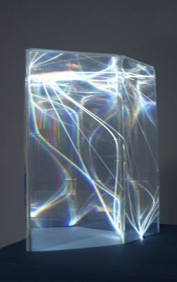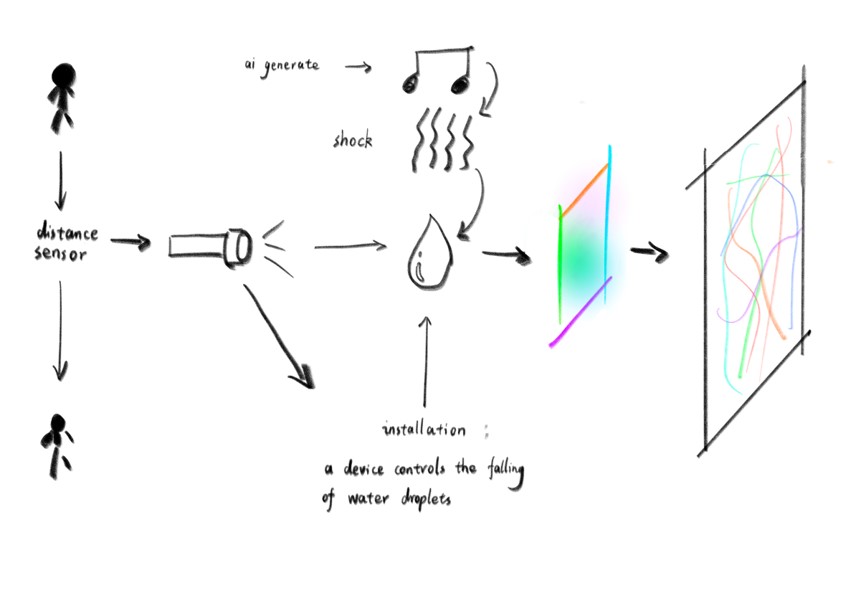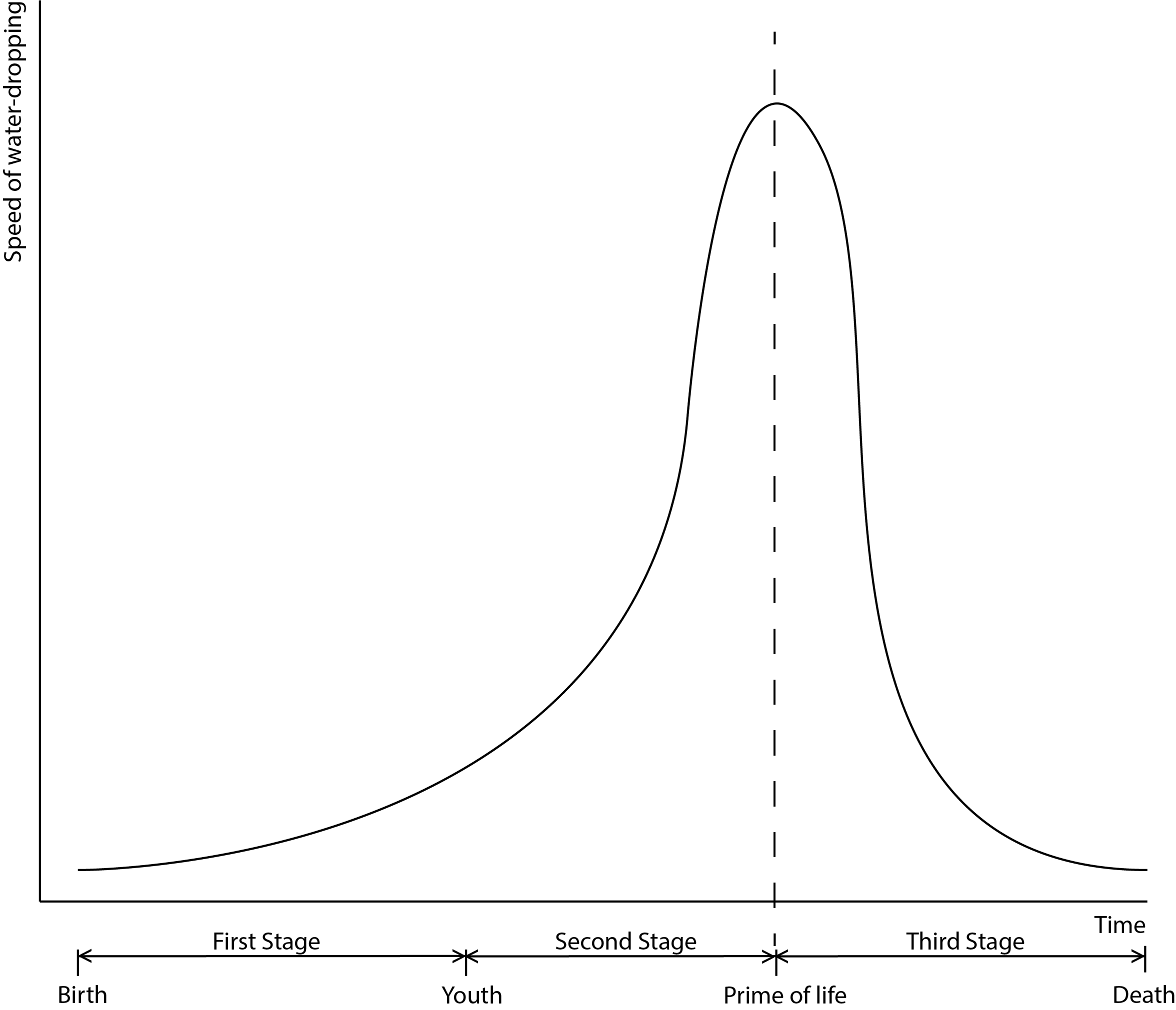Process Group 2
List of group members:
Initial Concept Generation
We confirmed our project keywords: Sound and AI. After a few days of brainstorming, we came up with some interesting preliminary ideas as follows:
- Sounds of the season: capturing the sounds of the seasons and synthesizing them into a piece of music with AI
- The world of color blindness: If I were a color blind person, could I experience the colorful world through sound
- Musical Puzzles: exploring whether someone who doesn’t know music can make a piece of music, through a collage (similar to a material puzzle, then synthesized with ai music)
- Musical visualization device: embodied music
- Vibrations of music (amplified) – water/vibrations of lines/line drawings/other media
- Music and Time: rhythm and the different frequencies of time, exploring whether music can change one’s perception of time
- A world of astigmatism: what would the world look like if I blurred your eyes (Using AI as an example, blur the image with hairy glass or water and use ai for analysis)
Among those ideas, we prefer the element of water, namely the fifth idea, and then we discussed the details and its way of realization.
Our initial scheme was:
A drop of water evaporates for 30 minutes. During the process, the vibration of sound will change the refraction of light, and display wonderful light and shadow exhibition. The process can be divided into three stages, similar to a person’s lifetime. Also, the music will be separated into three steps to cooperate with the changes. At the same time, there will be a projector for casting various environments and animation to create a more immersive experience for the audience.
In terms of sound design, the music is selected to represent the trajectory of different periods in life, using the vibrations of the speaker’s diaphragm to make contact with the wooden board, allowing a drop of water to resonate with the sound, which is perceived visually through the amplitude of the water drop’s rippling vibrations. Over time, the water droplets slowly and unconsciously evaporate, allowing for an association between perception and imagination, engaging the senses, and bringing about an interactive experience of time and space.
We collected some reference pictures and tutorials, and then created a mood board.




Dissection of “Process”
However, after our clarification to Jules on Thursday in week 3, Jules pointed out that our discussion was limited in the practical aspects, without the dissection of the concept of “Process” and the inclusion of AI. Therefore, we carried out an analysis of the concept of “Process” in two dimensions: the first one is the dissection of project content and connotation, and the second one is the dissection of the design process.
Dissection of the Process of our project Content
We analyzed the “Process” based on our initial concept of water projection. The analogy is applied to explain the project objects and connotations.
The water (the project object) is equivalent to me (the analogy object).
The dripping speed of the waterdrop represents the speed of my growth.
The size of the water in the container represents the extent of my development.
The light expresses society.
The beam of light striking the water means the influence of culture on us.
The vibration of sounds or music represents the influence of our family/others’ evaluation of us.
The light and shadow of water projected on the wall represent my image in the eyes of others.
The flow of water from less to more to none in this device shows the period of my life from birth to the completion of my sentence.
Dissection of our design process
AI artists are playing a more significant role in the art and Design field. Meanwhile, Hidden dangers and controversy are ensuing, such as the unclear copyright, the substitutability of AI artists to human artists, and the artistry of AI works of art. Therefore, we would like to discuss some questions:
- What role does AI play from the artist’s design process to the final production?
- Whether AI can replace artists in design or not?
- If AI intervenes in most of the content during the design process, can the final work touch the audience?
Under such questions, we designed a working flow to test the competition between AI artists and human artists through two controlled experiments.
| Human Artist | AI Artist | |
| First Stage | Take a series of photos, and create an animation based on the photos | The series of images is fed to AI, and the AI artist outputs continuous pictures for animation |
| Second Stage | Create music based on the animation created in the first stage | Generate music based on the animation video feeding to AI like Clip Interrogator |
| Third Stage | Exhibit two final composition works, and let the audience choose their favourite work | |
Final Preference
We prefer the dissection of the project content after analysis and plan on the two different understandings. From our perspective, AI is regarded as a tool for helping human artists broaden their minds. A personal initiative of a human artist is the reason for the origin and existence of art. In this case, we focus on our project content with AI working as a tool to compensate for our shortcomings. In addition, our work is expected to review social phenomena with social meaning rather than discuss “meaning”.
Besides, combining installation creation with coding is more challenging for us and needs to be tested, improved, deleted, and modified for the long term. For us, the process of challenging and creating is meaningful, so we will keep recording the project creation process.
The specific plan

Fig. 1. Text Flow of Project Process

Fig. 2. Picture Flow of Project Process
The installation includes a distance sensor. Once the audience approaches the sensor, the speaker, the light, and the water-dropping system start running. The speed of water dropping changes according to different stages. Ripples appear, and the speaker’s vibration can influence the water’s morphology and dynamics. Ray thought the laser paper and water project had notable water changes on the wall. When the water is full of the container installation, it will be poured away from the container. The whole process can be divided into three stages, where music and water-dropping speed are continuously changing.

Fig. 3. Graph of Relationship of Time and Speed of water-dropping
The speaker is placed flat under a table with a container, on top of the speaker’s diaphragm, water drops are placed in the container so that the drops create ripples through the sonic Hertzian vibrations of the music. We will take photos of the shadows and lights of the water and record some sounds. Those photos and sounds will be learned by AI, such as Mubert-text-to-music, disco diffusion, and clip interrogator, and then AI will generate some pieces of music. Before each stage starts, we invite an audience to pick one piece of music from the three parts we provide to influence the ripples.
Materials we need
Water, Mirror, Camera, Spotlights, Laser Paper, Transparent Container, Straws, Distance Sensor, Arduino Motherboard, Water-dropping Installation, Room without window or with curtain, Speaker, Speaker Diaphragm
Time Schedule
Week 1 – lecture
Week 2 – brainstorming, group discussion
Week 3 – modification and improvement of the project according to suggestions of Jules and Philly
Week 4 – decision on detailed design, material preparation and space lease
Week 5 & 6 – project testing, sound test, AI learning, installation design
Week 7 – testing in room
Week 8 & 9 & 10 – video editing, sound editing, Arduino coding and testing
Week 11 & 12 – complete testing
Week 13 – modification
Week 14 – final composition, video editing
Reference List
【TouchDesignerTutorials|Noise Creative Spin BallLeapMotion Gesture interaction】
【Audio-visual Interactive – Aurora_】
【Processing–Blowing interaction】
【Plant sensory visualisation/A sketchy interactive installation】
【Interactive artwork AS IF】
【Simple Motion Visualisation –Simple motion visualisation can be done using Kinect】
【Touchdesigner Sound and picture interactive lines】
【 “Water” ambient light – Arduino design】

